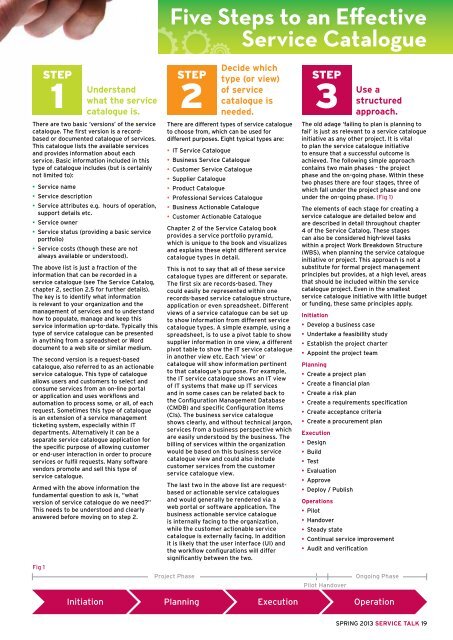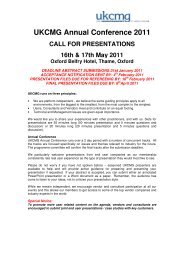SerVICe management - UKCMG
SerVICe management - UKCMG
SerVICe management - UKCMG
You also want an ePaper? Increase the reach of your titles
YUMPU automatically turns print PDFs into web optimized ePapers that Google loves.
Five Steps to an Effective<br />
Service Catalogue<br />
Understand<br />
what the service<br />
catalogue is.<br />
There are two basic ‘versions’ of the service<br />
catalogue. The first version is a recordbased<br />
or documented catalogue of services.<br />
This catalogue lists the available services<br />
and provides information about each<br />
service. Basic information included in this<br />
type of catalogue includes (but is certainly<br />
not limited to):<br />
• Service name<br />
• Service description<br />
• Service attributes e.g. hours of operation,<br />
support details etc.<br />
• Service owner<br />
• Service status (providing a basic service<br />
portfolio)<br />
• Service costs (though these are not<br />
always available or understood).<br />
The above list is just a fraction of the<br />
information that can be recorded in a<br />
service catalogue (see The Service Catalog,<br />
chapter 2, section 2.5 for further details).<br />
The key is to identify what information<br />
is relevant to your organization and the<br />
<strong>management</strong> of services and to understand<br />
how to populate, manage and keep this<br />
service information up-to-date. Typically this<br />
type of service catalogue can be presented<br />
in anything from a spreadsheet or Word<br />
document to a web site or similar medium.<br />
The second version is a request-based<br />
catalogue, also referred to as an actionable<br />
service catalogue. This type of catalogue<br />
allows users and customers to select and<br />
consume services from an on-line portal<br />
or application and uses workflows and<br />
automation to process some, or all, of each<br />
request. Sometimes this type of catalogue<br />
is an extension of a service <strong>management</strong><br />
ticketing system, especially within IT<br />
departments. Alternatively it can be a<br />
separate service catalogue application for<br />
the specific purpose of allowing customer<br />
or end-user interaction in order to procure<br />
services or fulfil requests. Many software<br />
vendors promote and sell this type of<br />
service catalogue.<br />
Armed with the above information the<br />
fundamental question to ask is, “what<br />
version of service catalogue do we need?”<br />
This needs to be understood and clearly<br />
answered before moving on to step 2.<br />
Fig 1<br />
STEP<br />
1<br />
STEP<br />
2<br />
Decide which<br />
type (or view)<br />
of service<br />
catalogue is<br />
needed.<br />
There are different types of service catalogue<br />
to choose from, which can be used for<br />
different purposes. Eight typical types are:<br />
• IT Service Catalogue<br />
• Business Service Catalogue<br />
• Customer Service Catalogue<br />
• Supplier Catalogue<br />
• Product Catalogue<br />
• Professional Services Catalogue<br />
• Business Actionable Catalogue<br />
• Customer Actionable Catalogue<br />
Chapter 2 of the Service Catalog book<br />
provides a service portfolio pyramid,<br />
which is unique to the book and visualizes<br />
and explains these eight different service<br />
catalogue types in detail.<br />
This is not to say that all of these service<br />
catalogue types are different or separate.<br />
The first six are records-based. They<br />
could easily be represented within one<br />
records-based service catalogue structure,<br />
application or even spreadsheet. Different<br />
views of a service catalogue can be set up<br />
to show information from different service<br />
catalogue types. A simple example, using a<br />
spreadsheet, is to use a pivot table to show<br />
supplier information in one view, a different<br />
pivot table to show the IT service catalogue<br />
in another view etc. Each ‘view’ or<br />
catalogue will show information pertinent<br />
to that catalogue’s purpose. For example,<br />
the IT service catalogue shows an IT view<br />
of IT systems that make up IT services<br />
and in some cases can be related back to<br />
the Configuration Management Database<br />
(CMDB) and specific Configuration Items<br />
(CIs). The business service catalogue<br />
shows clearly, and without technical jargon,<br />
services from a business perspective which<br />
are easily understood by the business. The<br />
billing of services within the organization<br />
would be based on this business service<br />
catalogue view and could also include<br />
customer services from the customer<br />
service catalogue view.<br />
The last two in the above list are requestbased<br />
or actionable service catalogues<br />
and would generally be rendered via a<br />
web portal or software application. The<br />
business actionable service catalogue<br />
is internally facing to the organization,<br />
while the customer actionable service<br />
catalogue is externally facing. In addition<br />
it is likely that the user interface (UI) and<br />
the workflow configurations will differ<br />
significantly between the two.<br />
Project Phase<br />
STEP<br />
3<br />
Use a<br />
structured<br />
approach.<br />
The old adage ‘failing to plan is planning to<br />
fail’ is just as relevant to a service catalogue<br />
initiative as any other project. It is vital<br />
to plan the service catalogue initiative<br />
to ensure that a successful outcome is<br />
achieved. The following simple approach<br />
contains two main phases - the project<br />
phase and the on-going phase. Within these<br />
two phases there are four stages, three of<br />
which fall under the project phase and one<br />
under the on-going phase. (Fig 1)<br />
The elements of each stage for creating a<br />
service catalogue are detailed below and<br />
are described in detail throughout chapter<br />
4 of the Service Catalog. These stages<br />
can also be considered high-level tasks<br />
within a project Work Breakdown Structure<br />
(WBS), when planning the service catalogue<br />
initiative or project. This approach is not a<br />
substitute for formal project <strong>management</strong><br />
principles but provides, at a high level, areas<br />
that should be included within the service<br />
catalogue project. Even in the smallest<br />
service catalogue initiative with little budget<br />
or funding, these same principles apply.<br />
Initiation<br />
• Develop a business case<br />
• Undertake a feasibility study<br />
• Establish the project charter<br />
• Appoint the project team<br />
Planning<br />
• Create a project plan<br />
• Create a financial plan<br />
• Create a risk plan<br />
• Create a requirements specification<br />
• Create acceptance criteria<br />
• Create a procurement plan<br />
Execution<br />
• Design<br />
• Build<br />
• Test<br />
• Evaluation<br />
• Approve<br />
• Deploy / Publish<br />
Operations<br />
• Pilot<br />
• Handover<br />
• Steady state<br />
• Continual service improvement<br />
• Audit and verification<br />
Pilot Handover<br />
Ongoing Phase<br />
Initiation<br />
Planning<br />
Execution<br />
Operation<br />
SPRING 2013 SERVICE TALK 19




